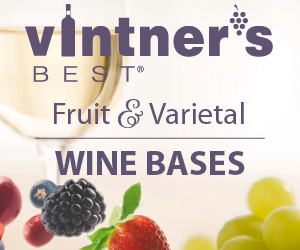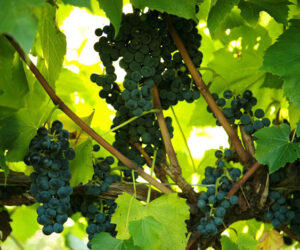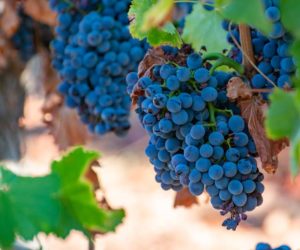 Being both a commercial and research winemaker, I am posed questions of all types. They could be questions on production techniques, yeast choices, to crush or not to crush, skin contact times for whites, when to press, barrel choices, and the list could go on and on. I usually respond to the question initially with the reply; “It depends . . .” This is sort of a cop-out answer, but I do take the time to explain some of the major points, and then there come a few follow-up questions that lead to another round of me saying “it depends . . .” The conversation then morphs to a different subject. When I am asked about grape growing and how it will be affected by climate change; I guess my answer would be “it depends,” but in reality, I don’t know. I am not sure there is a good answer but we attempted to look at that at UC-Davis a few years ago, and this feature is about a grape that was at the forefront of that brief project. It’s not really a specific grape variety, but rather a family of grapes originating in Italy. We’ll call it Trebbiano for now, but you will soon find out there are some grape varieties in the family that are closely related, others that we can call “adopted” into the family, while others may be lost relatives. It is afterall a rather big family covering several varieties.
Being both a commercial and research winemaker, I am posed questions of all types. They could be questions on production techniques, yeast choices, to crush or not to crush, skin contact times for whites, when to press, barrel choices, and the list could go on and on. I usually respond to the question initially with the reply; “It depends . . .” This is sort of a cop-out answer, but I do take the time to explain some of the major points, and then there come a few follow-up questions that lead to another round of me saying “it depends . . .” The conversation then morphs to a different subject. When I am asked about grape growing and how it will be affected by climate change; I guess my answer would be “it depends,” but in reality, I don’t know. I am not sure there is a good answer but we attempted to look at that at UC-Davis a few years ago, and this feature is about a grape that was at the forefront of that brief project. It’s not really a specific grape variety, but rather a family of grapes originating in Italy. We’ll call it Trebbiano for now, but you will soon find out there are some grape varieties in the family that are closely related, others that we can call “adopted” into the family, while others may be lost relatives. It is afterall a rather big family covering several varieties.
Trebbiano History
To start, the Trebbiano family consists of several traditional Italian grape varieties that share morphological characteristics. Those characteristics could be described as: Very light, white-ish berries, large clusters, late-ripening, and vigorous growth. In the literature, many theories exist on its origin, but the generally accepted version was in the year 1303 a grape under the name Tribiana, was widely cultivated along the Adriatic Coast in Emilia-Romagna in northern Italy. Whether this grape was one of the current varietals or a genetic parent, we do not know, but we do know that it was already well-established in its homeland. To go back further in time, no Italian grape story can be worthwhile without a mention by Pliny the Elder, who made reference to this lineage of grapes under the name vinum trebulanum. He talks of wines being made from grapes in an area around Trebula, (now known as Treglia) in the southern part of Italy (just north of Naples). Other authors maintain its origins in Tuscany, while another theory states its origins along the Trebbia River in the Emilia-Romagna region. All plausible and possible given the size of the family as we know it.
While the morphological characteristics of the plantings varied somewhat, it was long thought that they were all the same until DNA scientists showed significant variability among the family. Also that many Trebbiano grapes did not share a common ancestor. Jancis Robinson recognizes six distinct varieties with Trebbiano in their name: Trebbiano d’Abruzzo, Trebbiano Giallo, Trebbiano Modenese, Trebbiano Romagnolo, Trebbiano Spoletino, and Trebbiano Toscano. There are other varieties under the Trebbiano name: Trebbiano di Soave, Trebbiano Valtenesi, and Trebbiano di Lugana, but these latter three were found to be identical to Verdicchio Bianco. With all these different names, you can imagine how complicated the rules are when using these grapes under a DOC or DOCG designation. It must have been much simpler when they thought it was all the same grape.
Trebbiano d’Abruzzo, as the name implies, is from the Abruzzo region in central Italy. It is a lighter-skinned variety and was originally thought to be identical to Bombino Bianco in Puglia, to the south. Trebbiano Giallo and Trebbiano Modenese, are made as a base wine that is eventually made into balsamic vinegar. Trebbiano Giallo is also used for blending. Trebbiano Romagna is described as “not especially distinguished” although widely planted. It is made into still wines, but does better as the base cuvée for sparkling wines, or distilled into brandy. Trebbiano Spoletino is relatively new (released in 1878) to the Trebbiano family and thought to be a cross between an unknown parent and Trebbiano d’Abruzzo. It was saved from extinction in the early 2000s. Hard to believe that it was nearly lost because it is known for its ability to accumulate sugar, flavors of tropical fruit and spices while maintaining acidity.
Trebbiano Toscano has been the main white grape of Tuscany since the 1600s. It probably produces more wine than any other vine in the world. Some would argue that Spain’s Airen holds this distinction, but while the Airen vineyards are vast, they are lower yielding and Airen finds its way into brandy production. Here’s the real crux, Trebbiano Toscano is the same variety as Ugni Blanc (aka Saint-Émilion), and this is the member of the Trebbiano family that has traveled the world. The origins of Ugni Blanc date back to the fourteenth century when the Pope moved the papacy from Italy to Avignon, France. It adapted well and plantings of this variety soon spread out across southern France.
Trebbiano Viticulture
What makes it so successful are its viticultural characteristics. It is a late budding variety, keeping it out of the way of spring frosts. Mid- to late-ripening allows for flavor development, but it maintains acidity to give the wine structure. The vine is also vigorous and high yielding, which is a large part of the reasoning we came to this particular varietal when we were deciding to include it in our alternative varieties project at UC-Davis.
As Ugni Blanc, Trebbiano Toscano enjoyed extreme popularity in France because of its popularity with distillers. But its popularity is on the decline. There was once over 200,000 acres planted in France in 2009. It is used primarily in the production of Cognac. Back to the home turf in Italy, in 1990 there was over 150,000 acres declining to 100,000 acres ten years later. It is falling out of favor there too, since the DOC/DOCG rules requiring its use in the production of Tuscan red wines has changed. It is no longer an obligatory component of the Chianti Classico wines. Attempts for making dry whites have been met with oversupply and falling prices. Most of it is gobbled up to make Vin Santo. Still, 300,000 acres between France and Italy equals a whole heck of a lot of wine.
Elsewhere in Europe, this Trebbiano varietal has been experimented with in Portugal, Greece, Croatia, Bulgaria, and Russia. The Russians found out it was not very cold-tolerant and abandoned it. Outside of Europe, Argentina and Uruguay have planted over 7,000 acres as Ugni Blanc and in Brazil, where it is under the Trebbiano Toscano name, about 500 acres are planted. California listed just 200 acres as Saint-Émilion in 2016.
Trebbiano Enology
The challenges I had in making wines as part of the UC-Davis project was the acidity balance. We made wines under all three varietal names: Ugni Blanc, Trebbiano Toscano, and Saint-Émilion, because that is how the plots were laid out. The grapes were sourced from the southern San Joaquin Valley near Fresno, California. This project took place as California was enduring its fifth year of drought. I wasn’t the viticulturist on the project so I can’t get too technical on the rootstock and soil types, but we found ourselves with sugars in the 20–22 °Brix range with high pH (>3.7) and lower acidities (<4.0 g/L). In retrospect, a second year at this, I would have advised to let the grapes hang a little longer to accumulate sugar and flavor. But when the fruit came into the winery, we had to be very aggressive with judicious acid additions. As a sidenote, it is so important to realize that sometimes the best work in winemakin, is not the first work — although I can still taste that first Riesling wine I made over 25 years ago.
“The right grape for the right region” has long been a philosophy of mine. With local changes in weather patterns we need to look to traditional grape growing regions and how locals adapted. For our work, there were a lot of variables to consider and in the end, the scope was too large and the funding too small, so it went by the wayside. We showcased the wines in a warm weather grape-growing symposium and moved on. But success is where you put time into something to learn and re-learn. The Trebbiano family is a diverse and international grouping and its history in hot climates make it an ideal candidate for further study. Sister Sledge put it right, when they recorded the tune We Are Family. The line goes “Can they be that close?” and “we are giving love in a family dose”. Trebbiano is the family giving love and promise to the grape-growing world based on tradition and now hopefully in the future, science.
Trebbiano Recipe — Yield 5 gallons (19 L)
Ingredients
100 lbs. (45 kg) Trebbiano fruit
Distilled water
10% potassium metabisulfite (KMBS) solution
Weigh 10 grams of KMBS, dissolve into about 75 milliliters (mL) of distilled water. When completely dissolved, make up to 100 mL total with distilled water.
5 grams Lallemand QA23 yeast
5 grams Fermaid K (or equivalent yeast nutrient)
5 grams Di-ammonium phosphate (DAP)
Other equipment or needs
5-gallon (19-L) carboy
6-gallon (23-L) carboy
6-gallon (23-L) plastic bucket
Airlock and stopper
Racking hoses
Inert gas (nitrogen, argon or carbon dioxide will do)
Refrigerator (~45 °F/7 °C) to cold settle the juice. (Remove the shelves so that the bucket will fit.)
Ability to maintain a fermentation temperature of 55 °F (13 °C)
Thermometer capable of measuring between 40–110 °F (4–43 °C) in one degree increments
Pipettes with the ability to add in in- crements of 1 milliliter
Clinitest® tablets to measure resid- ual sugar at the completion of fermentation
Ability to test or have testing per- formed for sulfur dioxide
Step by Step
1. Crush and press the grapes. Do not delay between crushing and pressing. Move the must directly to the press and press lightly to avoid extended contact with the skins and seeds.
2. Transfer the juice to a 6-gallon (23-L) bucket. During the transfer, add 3 mL 10% KMBS solution per gallon (11 mL/L) of juice. (This addition is the equivalent of 50 ppm SO2). Move juice to the refrigerator.
3. Let the juice settle at least overnight. Layer the headspace with inert gas and keep covered.
4. When sufficiently settled, rack the juice off of the solids into the 6-gallon (23-L) carboy.
5. Add Fermaid K or similar yeast nutrient (5 grams).
6. Prepare yeast. Heat about 50 mL distilled water to 104 °F (40 °C). Do not exceed this temperature as you will kill the yeast. Sprinkle the yeast on the surface of the heated water and gently mix so that no clumps exist. Let sit for 15 minutes undisturbed. Measure the temperature of the yeast suspension. Measure the temperature of the juice. You do not want to add the yeast to your cool juice if the temperature difference exceeds 15 °F (8.3 °C). Acclimate your yeast by taking about 10 mL of the cold juice and adding it to the yeast suspension. Wait 15 minutes and measure the temperature again. Repeat until you are within the specified temperature range. When the yeast is ready, add it to the carboy.
7. Initiate the fermentation at room temperature (65–68 °F/18–20 °C) and once fermentation is noticed, (~24 hours) move to a location where the temperature can be maintained at 55 °F (13 °C). If using the refrigerator be sure to monitor your fridge temperature as some older models can be too cold even at the warmest temperature. If your fridge is too cold (colder that 55 °F/13 °C), and external temperature controller can be utilized to maintain temperature.
8. Two days after fermentation starts, dissolve the DAP in as little distilled water required to completely go into solution (usually ~20 mL). Add directly to the carboy.
9. Normally you would monitor the progress of the fermentation by measuring Brix. One of the biggest problems with making white wine at home is maintaining a clean fermentation. Entering the carboy to measure the sugar is a prime way to infect the fermentation with undesirable microbes. So at this point, the presence of noticeable fermentation is good enough. If your airlock becomes dirty by foaming over, remove, clean, and replace as quickly as possible. Sanitize anything that will come in contact with the juice.
10. Wait until bubbles in the airlock are about one bubble per minute.
11. After about 2–3 weeks, it is time to start measuring the sugar. Sanitize your thief; remove just enough liquid to use for your hydrometer. Record your results. If reading is greater than 7 °Brix wait another week before measuring. Discard the juice. If the Brix is less than 7 °Brix; begin measuring every other day. Continue to measure the Brix every other day until two readings in a row read negative and the same. This should be -1.5 °Brix or lower for a dry wine.
12. Taste the wine, it should be clean.
13. If the wine is dry, rack to the 5-gallon (19-L) carboy and control for headspace. Add 3 mL per gallon (11 mL/L) of 10% KMBS solution (to inhibit any malolactic fermentation) then lower the temperature of the wine to ~45 °F (7 °C).
14. Let the lees settle for about 2 weeks and stir them up. Repeat this every 2 weeks for eight weeks. This will be a total of four bâtonnage stirs. You’re doing this to enhance the mouthfeel. The whole process is known as sur lie aging.
15. After the second stir, check SO2 and adjust to 30–35 ppm free SO2
16. Let the lees settle. At this point, the wine is going to be crystal clear or a little cloudy. If the wine is crystal clear, then that is great! If the wine is cloudy, then presumably, if you have kept up with the SO2 additions and adjustments, temperature control, kept a sanitary environment, and there are no visible signs of a re-fermentation, then this is most likely a protein haze. You can choose to fine with bentonite to clarify.
17. While aging, test for SO2 and keep maintained at 30–35 ppm. Titratable acidity (TA) target is about 6.5 g/L. The pH target is around 3.4–3.5, but rely more on the TA as that will contribute to mouthfeel. You do not want an overly acidic wine.
18. Once the wine is cleared it is time to move it to the bottle. This would be about six months after the onset of fermentation. If all has gone well to this point, given the quantity made, it can probably be bottled without filtration. Your losses during filtration could be significant. That said, maintain sanitary conditions while bottling and you should have a fine example of a clean, creamy Trebbiano wine. Enjoy!






